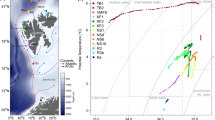Abstract.
Morphological characteristics and sinking velocities of naturally occurring fecal pellets of copepods, euphausiids, salps, and pelagic mollusks collected in the northeastern tropical Atlantic were investigated during the period of May–June 1992. The fecal pellets of copepods and euphausiids were cylindrical and distinguished only by their size. Those of salps were, in general, rectangular, and slight differences were noted according to the species. The fecal pellets of the molluscan pteropod Clio sp. were conical, while those of the molluscan heteropod Carinaria sp. were spiral. The sinking velocities ranged from 26.5 to 159.5 m day–1 for copepod fecal pellets, from 16.1 to 341.1 m day–1 for euphausiid pellets, from 43.5 to 1167.6 m day–1 for salps' pellets (Cyclosalpa affinis, Salpa fusiformis, Iasis zonaria, and two unidentified species), from 65 to 205.7 m day–1 for Clio sp. pellets, and from 120.3 to 646.4 m day–1 for Carinaria sp. fecal pellets. The measured sinking velocities were compared with estimates predicted using the equations of Komar et al. (1981; Limnol Oceanogr 26:172–180), Stokes' law, and Newton's second law, using either a constant density of fecal pellets (1.22 g cm–3) or densities estimated with the three different equations. When a constant density was used, the three equations overestimated the sinking velocities; Stokes' law resulted in the largest overestimation, and Newton's second law, the smallest. At the taxa level, the overestimation was greatest for euphausiid 1 fecal pellets and smallest for copepod fecal pellets. When the three equations were used to estimate fecal pellet density, the density estimated using the equation of Komar et al. was the greatest, and that using Stokes' law, the smallest, resulting in over- and underestimation of sinking velocities, respectively. Newton's second law resulted in an intermediate density and gave the closest estimate of sinking velocities. We propose that measurement of sinking velocities of a portion of the fecal pellets might guide in choosing an appropriate equation to be used for a reasonable interpretation of vertical mass flux.
Similar content being viewed by others
Author information
Authors and Affiliations
Additional information
Electronic Publication
Rights and permissions
About this article
Cite this article
Yoon, .W., Kim, .S. & Han, .K. Morphology and sinking velocities of fecal pellets of copepod, molluscan, euphausiid, and salp taxa in the northeastern tropical Atlantic. Marine Biology 139, 923–928 (2001). https://doi.org/10.1007/s002270100630
Received:
Accepted:
Issue Date:
DOI: https://doi.org/10.1007/s002270100630



